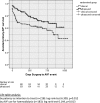Routine preoperative vascular ultrasound improves patency and use of arteriovenous fistulas for hemodialysis: a randomized trial
- PMID: 20829420
- PMCID: PMC2994085
- DOI: 10.2215/CJN.02820310
Routine preoperative vascular ultrasound improves patency and use of arteriovenous fistulas for hemodialysis: a randomized trial
Abstract
Background and objectives: Arteriovenous fistulas (AVFs) are the preferred vascular access for hemodialysis but have a considerable failure rate. This study investigated whether routine preoperative vascular ultrasound results in better AVF outcome than physical examination.
Design, setting, participants, & measurements: Patients with end-stage kidney disease referred for permanent access formation were assessed by independent examiners using physical examination and ultrasound. After random allocation, the ultrasound report was disclosed to the surgeon for patients in the ultrasound group but not for the clinical group. End points were AVF failure and survival rates, analyzed by intention to treat and by use for hemodialysis.
Results: AVFs were made in 208 of 218 randomized patients. Clinical and ultrasound groups were similar in terms of patient characteristics, allocation to individual surgeons, and proportion of forearm AVFs. The ultrasound group had a significantly lower rate of immediate failure (4% versus 11%, P = 0.028) and, among failed AVFs, less thrombosis (38% versus 67%, P = 0.029). Primary AVF survival at 1 year was not statistically different (ultrasound = 65%, clinical = 56%, P = 0.081). Assisted primary AVF survival at 1 year was significantly better for the ultrasound group (80% versus 65%, P = 0.012). The number of patients requiring preoperative ultrasound to prevent one AVF failure was 12.
Conclusions: Routine preoperative vascular ultrasound in addition to clinical assessment improves AVF outcomes in terms of patency and use for dialysis. National Research Register, United Kingdom, trial number N0046131432.
Figures
References
-
- National Kidney Foundation Kidney Disease Outcomes Quality Initiative: 2006 update vascular access. Guideline 2: Selection and placement of hemodialysis access. Am J Kidney Dis 48[Suppl 1]: S192–S200, 2006
-
- Tordoir J, Cannaud B, Haage P, Konner K, Basci A, Fouque D, Kooman J, Martin-Malo A, Pedrini L, Pizzarelli F, Tattersall J, Vennegoor M, Wanner C, ter Wee P, Vanholder R. EBPG on vascular access. Nephrol Dialysis Transplant 22[Suppl 2]: ii88–ii117, 2007 - PubMed
-
- Rooijens PPGM, Tordoir JHM, Stijnen T, Burgmans JPJ, de Smet AAEA, Yo TI. Radiocephalic wrist arteriovenous fistula for hemodialysis: Meta-analysis indicates a high primary failure rate. Eur J Vasc Endovasc Surg 28: 583–589, 2004 - PubMed
-
- Lok CE, Oliver MJ, Su J, Bhola C, Hannigan N, Jassal SV: Arteriovenous fistula outcomes in the era of the elderly dialysis population. Kidney Int 67: 2462–2469, 2005 - PubMed
-
- Miller PE, Tolwani A, Luscy CP, Deierhoi MH, Bailey R, Redden DT, Allon M: Predictors of adequacy of arteriovenous fistulas in hemodialysis patients. Kidney Int 56: 275–280, 1999 - PubMed
Publication types
MeSH terms
LinkOut - more resources
Full Text Sources
Medical




